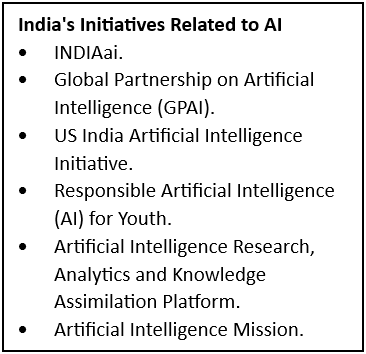- Courses
- GS Full Course 1 Year
- GS Full Course 2 Year
- GS Full Course 3 Year
- GS Full Course Till Selection
- Answer Alpha: Mains 2025 Mentorship
- MEP (Mains Enrichment Programme) Data, Facts
- Essay Target – 150+ Marks
- Online Program
- GS Recorded Course
- Polity
- Geography
- Economy
- Ancient, Medieval and Art & Culture AMAC
- Modern India, Post Independence & World History
- Environment
- Governance
- Science & Technology
- International Relations and Internal Security
- Disaster Management
- Ethics
- NCERT Current Affairs
- Indian Society and Social Issue
- NCERT- Science and Technology
- NCERT - Geography
- NCERT - Ancient History
- NCERT- World History
- NCERT Modern History
- CSAT
- 5 LAYERED ARJUNA Mentorship
- Public Administration Optional
- ABOUT US
- OUR TOPPERS
- TEST SERIES
- FREE STUDY MATERIAL
- VIDEOS
- CONTACT US
AI in 2023: Innovations, Ethics, and Global Initiatives
AI in 2023: Innovations, Ethics, and Global Initiatives
02-01-2024

Context
- 2023 marks a significant year for AI innovation, showcasing advancements in creativity, conversation, and visual content generation.

- Highlights the crucial need for enhanced oversight to ensure the ethical use and equitable access to AI benefits.
What is Artificial Intelligence?
- AI is the ability of machines to acquire and apply knowledge for intelligent behaviour.
- Coined by John McCarthy, an American computer scientist, and cognitive scientist.
- Encompasses technologies like machine learning, deep learning, big data, neural networks, computer vision, and large language models.
- It’s ideal characteristic is the ability to rationalize and take actions to achieve specific goals.
Types of AI
Based on Capabilities |
Description |
|
|
|
|
|
|
Based on Functionality |
Description |
|
|
|
|
|
|
|
|
Principles for the Ethical Use of AI
- AI initiatives should align with established ethical principles, human rights, and societal values.
- Prioritize the positive impact of AI on individuals, communities, and society for responsible technological advancement.
- Design AI systems to be transparent and explainable, allowing users and stakeholders to understand operations and decision-making processes, fostering trust and accountability.
- Biases in AI algorithms should be mitigated to ensure fair outcomes and prevent discrimination.
- Individuals' privacy rights should be upheld by responsibly handling personal data and complying with privacy laws.
- Clear lines of accountability for developers and organizations deploying AI systems should be established.
Major AI Tools
Tool |
Description |
ChatGPT |
|
Bing AI Chat/Microsoft Copilot |
|
Runway Gen-2 |
|
DALL-E 3 |
|
Midjourney |
|
Pi Chatbot |
|
Claude 2 by Anthropic |
|
Character AI |
|
GitHub Copilot |
|
Adobe Firefly |
|
Perplexity AI |
|
Google Bard |
|
Risks Associated / Problems |
Solutions |
|
|
Area |
About |
Applications |
Challenges |
AI in Healthcare |
|
|
|
AI in Agriculture |
|
|
|
Multimodal AI |
|
|
|
AI in Finance Sector |
|
|
|
AI Applications in Indian Conditions
- Complementing Digital India Mission: AI aids in big data analysis, a crucial aspect for the success of the Digital India Mission.
- Targeted Service Delivery: Enables precise delivery of services, schemes, and subsidies.
- Smart Border Surveillance: Enhances security infrastructure through intelligent monitoring.
- Proactive Weather Forecasting: AI-driven models can proactively address weather-related challenges, aiding in disaster preparedness for issues like floods and droughts.
- Road Safety and Crime Policies: Analysis of big data, including road safety and NCRB crime data, informs policymaking.
- Disaster Management: AI, robots, and intelligent machines expedite and improve disaster management.
- Counterinsurgency and Patrolling: Robotic army deployment reduces human personnel losses in counterinsurgency and patrolling operations.
- Automation of Government Processes: AI automates government processes, minimizing human interactions and enhancing transparency.
- Healthcare Modernization: AI studies ancient medicinal literature, contributing to modernizing healthcare with a blend of traditional techniques and modern machines.
- Governance in Remote Areas: In areas with weakened governance like tribal and hilly regions, AI can efficiently operate.
Nodal Organization for AI Research in India
- Centre for Artificial Intelligence and Robotics (CAIR): DRDO's primary laboratory in Bangalore, established in 1986.
- Focus Areas: Specializes in defense, Information and Communication Technology (ICT), and intelligent systems research and development.
- CAIR Projects:
- NETRA: Software for intercepting online communication.
- SECOS: Development of a secure operating system.
- MCA 3.0 Portal: Introduced by Ministry of Corporate Affairs (MCA). It simplifies regulatory filings for companies, aligning with the goal of promoting ease of doing business and compliance monitoring.
- AI Portal: Jointly developed by MeitY and NASSCOM in June 2020, the India AI portal serves as a central hub for AI-related developments and initiatives in India.
Deepfakes
How Deepfakes Work?
Key Provisions of the Advisory released by Government
Regulatory Measures
|
|
Challenges/Issues |
Solutions |
|
|


